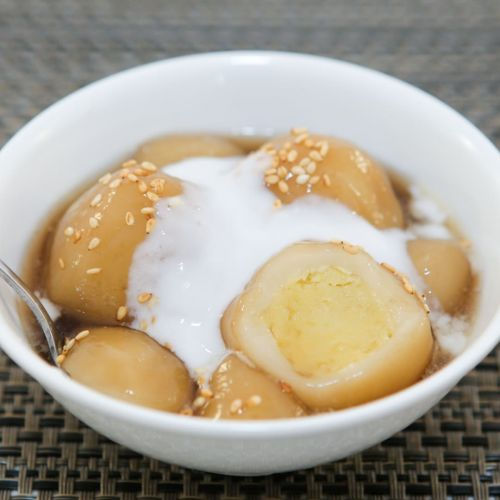The Versatile Dessert - Chè
- Silk Babes

- Dec 30, 2021
- 3 min read
Updated: Dec 31, 2021
Written by Judy Ngo
Graphic by Ira San Andres

Imagine if there was a dessert that had an unimaginable amount of flavor and texture? Well, I’m here to tell you that such a dessert exists. It’s called chè or Vietnamese sweet soup, dessert, pudding, or drink. This delicious snack/dessert staple can be found anywhere in the country of Vietnam. It can be served in either a bowl, large glass, or more commonly in a little plastic cup. You’ll typically see people eat chè with ice alongside the streets of Vietnam as a way to cool down in the sweltering heat. This Vietnamese dessert is perfect all year round since it can be served hot or cold. The word chè includes dozens upon dozens of different varieties each with their own unique qualities. However, most chè comes with coconut cream that you could add on top. Here is a list of some of the kinds chè that I love:

Chè Ba Máu - Three Colors Dessert
This particular dessert is my mother’s personal favorite as it always reminds me of her. She’d always ask me to pick her up a cup of chè ba màu from Bambu, a Vietnamese drinks chain, whenever she wanted to give herself a little treat. It’s famous for its three distinct colors and layers which are usually red kidney beans or red beans, yellow mung beans, and green pandan jelly. It’s typically enjoyed cold with a topping of crushed ice and some coconut cream. It’s less sweet than other chè,making it perfect for those who don’t have a sweet tooth.

Chè Đậu Trắng - Black Eyed Pea Pudding/Dessert
This is hands down my favorite chè of all time. It’s a super simple dessert consisting of sticky rice, black-eyed peas, and coconut cream. It’s served warm, but I personally eat it hot because the process of blowing on a spoon of piping hot chè makes the eating experience ten times better. It’s best enjoyed with a generous helping of coconut cream on top. Chè đậu trắng is a tad sweeter than most varieties because of the sticky rice. However, the coconut cream helps with leveling down the sweetness while adding a nice creamy flavor to the whole dessert.

Chè Thái - Vietnamese Fruit Cocktail
This Vietnamese fruit cocktail is a delicious concoction of ingredients. It combines fruit, jellies, and coconut milk. It’s usually served cold in a glass without shaved ice since there’s already so much going on in it. The main fruits in the dessert are lychee, longan, jackfruit and sometimes toddy palm. In my opinion, the signature part of the mixture is the water chestnut with its signature, vibrant red color. They stand out in the coconut milk and give it a nice chewy texture when eaten. I love how refreshing this cocktail is because of all the fruits and cool coconut milk. It’s a great chè to try if it’s your first time trying it.

Chè Trôi Nước - Sticky Rice Balls in Ginger Syrup
This is my second favorite chè because the texture is amazing. It’s eaten warm or hot however, I wouldn’t recommend eating it cold since the characteristic glutinous chew of the rice balls would simply be lost. The texture can be compared to a dense boba ball. The sticky rice balls are often stuffed with mung bean paste which compliments the sticky exterior. These stuffed balls are drenched in a slightly golden ginger syrup that is incredibly aromatic. The dessert is usually topped with sesame seeds for a touch of nuttiness. Chè trôi nước is almost like a good cup of honey ginger tea, but more fun since there’s texture.

Chè Bắp - Sweet Corn Pudding
This chè is not to be confused with chè đậu ván which has a similar color and consistency. Chè đậu ván is made with yellow mung beans instead of corn, but it’s equally as delicious. There are two ways the corn can be presented, northern or southern. . The northern version of the dessert uses whole corn kernels while the southern version uses shaved corn kernels. The corn contains the right amount of sweetness to them when combined with the sticky rice and a small dollop of coconut cream. It’s usually served warm. There was always a plastic cup of chè bắp that made its way into our fridge when we went grocery shopping. It wouldn’t be a surprise to see it gone by the following night as it is my father’s favorite.




Comments